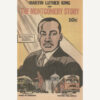It’s all about demographics.
In 2015, the Census Bureau reported that 50.3% of children younger than five already belonged to “minority” populations. By 2044, the Bureau projects, the United States will be a “majority minority” nation. (Pew Research gives the transformation date as 2055.) This expectation has been widely publicized, and its impact is widely felt among White people who see themselves as dispossessed from a centrality that they previously took for granted. For many, this de-centering is disorienting, and for some, outright scary. (Already in 2013, according to a poll undertaken by Latino Decisions for the Center for American Progress, 61% of conservative Whites and 56% of Whites 65 and older expected “rising diversity” to lead to increased discrimination against them.) The most spectacular result of today’s White malaise is, of course, Donald Trump.
It’s scarcely a secret that “Make America Great Again” really means “Take Us Back Before 1965,” when White people were 85% of the population and minorities stayed on the margins where they belonged. Fifty-eight percent of all non-Hispanic White American voters (according to Pew Research) put Trump where he is today. If he and his like are not to remain the public face of the United States for decades to come, several things need to happen. One is that a good number of those same White voters will have to change their minds. The rest of us cannot simply take it for granted that they will. How to help them do so is a subject of some debate.
The argument is often that widespread White support for Trump is mostly a matter of economics. Factory jobs are largely gone; fossil fuels are increasingly obsolete: there’s scarcely any work for the working class. Meanwhile, growing income inequality and the abandonment of corporate investment in workers’ job security have devastated the middle class, too. People who grew up with expectations of prosperity simply cannot find that comfort anymore. Such people’s new sense of the perilous uncertainty of life begins to verge on the long-time experience of … members of minority populations.
There is a White economic problem, and it’s more than numbers. (White people are still economically better off than Black people – who are affected by the same forces – by a substantial margin.) It’s not knowing how to cope, or what to do. In a word, White people have panicked. And to someone overwhelmed by a threatening new development, anything that promises to roll back that development can look like a very good deal. Once the survival reflexes of the amygdala kick in, even the rational mind – let alone the better angels of our nature – has a very tough time being heard. “Let’s get rid of the threat! Now!” takes neural priority over practically everything else. Demagogues have been exploiting that fact for as long as there have been human beings. But very little that is useful can be accomplished in such a condition. We need to count backwards from five to calm down.
If we do calm down, we are likely to notice that physical threats to our physical well-being from other people whom we do not know are actually rather rare. Despite a widespread common belief to the contrary (and the occasional passing uptick), violent crime in the U.S. has been strongly and consistently trending down since the 1970s, and crimes when they do occur tend to take place within demographic groups rather than across their boundaries. The chances of losing one’s life in a terrorist incident are approximately the same as the chances of being done in by falling furniture. (And for the record, the chance of succumbing to a serial killer, that central figure of the American popular imagination, is .00039%. The chance of being eaten by a zombie is zero.)
We are also likely to notice that those jobs being “taken” by Brown people from south of the border are frequently very difficult jobs indeed, at very small wages, that very few other people are even willing to try to do. No survival threat there, either. In fact, we owe those workers, so many of whom are in agriculture, a significant debt of gratitude for our survival.
So where’s the threat? The threat is to identity. Impending loss of majority status places White identity in a state of acute crisis. The election of the first Black president brought this crisis to a head, and with Trump the storm has fully broken upon us. Because who are White people, exactly, if White people are not in charge? Can Whiteness even exist without White supremacy?
There is a reasonable claim to be made that it cannot. And if that’s so, then White identity has reached a dead end. Something else will have to arise to take its place.
Historian Nell Irvin Painter, in The History of White People, has traced the origin of our contemporary sense of Whiteness not to any antique comparison between people of color and paler people, but to Enlightenment-era race theories that posited a natural superiority of some European populations over others. (Actual or mythical Saxon heritage, linked inexplicably to the ancient Greeks, was very popular as indicating a God-given right to be the boss; skull shape became the magic indicator.) Another thread, traced by other scholars, links Whiteness to a different convenient God-given right, this time the right of Christian rulers to conquer, colonize, and claim legal title to lands populated by non-Christians. Known as the Doctrine of Discovery, this 1493 papal decision on behalf of European rulers was declared by John Marshall and Thomas Jefferson as applying to the government of the United States – which in those days meant a rich, male, theoretically “Saxon” government. For the sake of defeating internal dissent, that fledgling government was soon to be rebranded as White.

But today we have forgotten all that. Back in the Good Old Days, pre-1965, Whiteness was blissful ordinariness. White people embodied the example of what it meant to be an American, and whoever else hoped to be included in the American project would aim to adopt White ways. Whiteness was the mainstream, the normal, the identity that required no self-awareness of its participants. In fact, as historians show us, taking on White identity pretty much required the abandonment of self-awareness, as one group after another gave up roots and embraced amnesia in order to be admitted into the club. Poles were not always White, nor Irish; certainly not Jews. Italians were very late to be let in the door: in 1898, they were almost disenfranchised along with Black people in Louisiana, where the two groups were viewed as equivalent dangers to society, and cultivated significant solidarity. (Italians, as non-Whites, were also lynched in that state, a fact that is scarcely in circulation among Italian-Americans today.)
It was only after political operators discovered that solidarity among the dangerous poor could be split – and established wealth protected – by assigning some poor people a special status, shared with the rich, that could be denied to others equally poor (as Lillian Smith, Tim Wise, and many others have documented), that Whiteness as we know it gained its stranglehold on the American mind.
Geneticists agree that there are NO reliable biological markers for “race” among human beings: the concept is wholly a social construction. There are more genetic differences within “races” than there are between them. Many racial categories, however, do indicate some kind of common history. The odd thing about Whiteness is that it bears almost no common history. It is the emptiest of labels, without any content beyond a deeply inculturated sense of importance upon which many, many people have come to rely. Remove the structural supports propping up this self-congratulation, and White identity has essentially nothing to offer to the very people who have been raised to claim it. The flag, motherhood, apple pie, baseball? Even if they were not already common property with others, are such emblems really enough to support a meaningful human life? Rugged individualism and redemptive violence offer even less, since they break the heart.
So what White people are struggling to hold on to, for the sake of our dignity, is ownership of the American dream of freedom. But the American dream stopped being a White franchise way back in 1965. And in our time, Whiteness and Americanness are reaching a parting of the ways. The idea of America is just too big to be owned.
The struggle of our era, therefore, is between the dying past and the emerging future: between America as a White Christian country, and America as a great human experiment. And in all such struggles, the future eventually wins. As Buckminster Fuller said, in the idiom of his times, “America isn’t a nation, it’s the launching pad for crossbreeding global man.” Langston Hughes put it even more elegantly: “America will be.”
But all this leaves White people at a loss. If America has grown far beyond us, then what are we? Without resorting to flagrant denial, or walling ourselves into a bunker – and both impulses characterize White politics today –how are we to locate ourselves among our fellows with a degree of simple pride?
Black people have renamed and reimagined themselves many times during their sojourn in this country. Now that we can contemplate being a minority ourselves, maybe it’s White people’s turn. There’s nothing to prevent us from looking at this whole thing in a different way.

Long before the social project called America was even a seed in a single dreaming mind, the land that project would someday occupy had a reality and a majesty of its own. The place and the project are not the same, and the name of the place is Turtle Island.
Turtle Island is what the people who lived here first call the whole “North American” continent, from what Europeans came to know as Panama to what they came to know as Alaska. But the people who lived here first never stopped calling it Turtle Island. And if the Doctrine of Discovery no longer enthralls us newcomers, then we are free to admit that Turtle Island remains its proper name.
There’s an ancient doctrine in many traditions that in order to understand things properly, one must first call them by their proper names. And once we can name our place, we can name ourselves.
All of us who have come here of our own free will, neither stolen nor transported, but out of a hope and a wish in our own hearts or the hearts of our ancestors, in flight from something or in search of something, are Turtle Island immigrants. In the eye of objective history, that’s exactly who we are. And in this regard a new arrival from Syria or Senegal is identical to a member of the DAR. Despite the multiplicity of our backgrounds, there’s not one of us who hasn’t begun as a pilgrim to these shores. We are all together, as in a fairy tale, the people who set out to seek their fortune. To be a Turtle Island Immigrant is to have a story worth telling.
Of course it is not the only story worth telling. There are those of us whose ancestors did come here as stolen or transported. Interestingly, they are not all people of African descent. Nell Painter points out that a good many European “undesirables” were exiled to Turtle Island in the early days as indentured servants. Chinese workers also were imported, exploited, and expelled. So in some respects they all share a story … and the shared story of involuntary arrival is different from the shared story of immigration. Sherman Jackson argues in his seminal Islam and the Blackamerican that the great gift of Black people to American society as a whole is the institution of a permanent culture of critique. And it may be that some people who have been in the habit of thinking of themselves as White will also find resonance and satisfaction in that culture of critique. For only a relentless critical voice – a conscience – can confer integrity upon the American project.

And lastly there are the people who lived here first. Honoring them returns the whole project to its context, and begins to undo the most primal of White wrongs. For the European monarchs let their subjects come to Turtle Island in the first place in order that they themselves could seize possession of the land. The people who lived here first were astounded by that, because their civilizations were far more ecologically sophisticated than the civilizations of Europe. They knew that the land was not a dead thing to be possessed, but a living being to be cherished. To the extent that the descendants of Europeans free ourselves from the tyranny of Whiteness, we will finally be able to grasp this fundamental truth. And then the people formerly known as White, instead of restlessly destroying everything around them, will feel at peace and be at home on Turtle Island, surrounded by neighbors and friends.
So there is a beautiful way forward waiting for all of us. What have Trump and his ilk got to offer that could even begin to compare?







